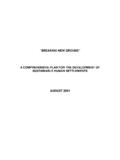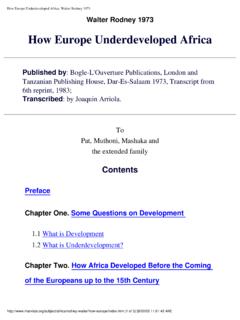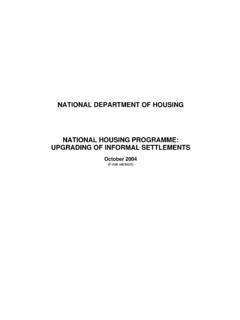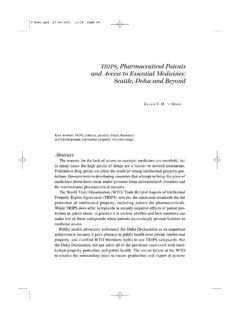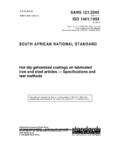Transcription of Explaining the Apartheid City: 20 Years of South African ...
1 Explaining the Apartheid city : 20 Years of South African Urban HistoriographyAuthor(s): Paul MaylamSource: Journal of Southern African Studies, Vol. 21, No. 1, Special Issue: Urban Studies andUrban Change in Southern Africa (Mar., 1995), pp. 19-38 Published by: Taylor & Francis, URL: : 25/08/2009 11:50 Your use of the JSTOR archive indicates your acceptance of JSTOR's Terms and Conditions of Use, available JSTOR's Terms and Conditions of Use provides, in part, that unlessyou have obtained prior permission, you may not download an entire issue of a journal or multiple copies of articles, and youmay use content in the JSTOR archive only for your personal, non-commercial contact the publisher regarding any further use of this work.
2 Publisher contact information may be obtained copy of any part of a JSTOR transmission must contain the same copyright notice that appears on the screen or printedpage of such is a not-for-profit organization founded in 1995 to build trusted digital archives for scholarship. We work with thescholarly community to preserve their work and the materials they rely upon, and to build a common research platform thatpromotes the discovery and use of these resources. For more information about JSTOR, please contact & Francis, Ltd. is collaborating with JSTOR to digitize, preserve and extend access to Journal ofSouthern African of Southern African Studies, Volume 21, Number 1, March 1995 19 Explaining the Apartheid city : 20 Years of South African Urban Historiography PAUL MAYLAM (Department of History, Rhodes University) The theme of urban segregation/ Apartheid has generated a considerable body of scholarly writing in the past 20 Years .
3 This urban research has been highly interdisciplinary, mainly involving geographers and historians and has tended to be afrocentric in focus. Numerous case studies have been produced, but few works that have synthesised or theorised. Much attention has been given to the process of urban segregation, as scholars have traced its origins and tried to explain the imperatives and mechanisms that governed the process. The overall picture to emerge shows urban segregation evolving over a long period of time in a rather haphazard, piecemeal way. The continuities before and after both the 1923 Natives (Urban Areas) Act and the 1950 Group Areas Act are more striking than the discontinuities.
4 South African urban historical research has also provided a clearer understanding of such themes as housing policy, urban 'native administration' and influx control, but has generally not succeeded in elucidating the central - local state relationship in the making of urban policy. South African urban historiography has -also been infuenced by the recent trend away from materialist analysis. While the abandonment of reductionism and mecha- nistic explanations is welcomed, this article stresses the importance of material forces in the making of urban segregation and Apartheid . Twenty Years ago South African urban historiography was in its infancy.
5 Few scholars had engaged in any critical historical analysis of urbanisation, urban policy or the urban experience. When David Welsh wrote his chapter, 'The Growth of Towns', for the Oxford History of South Africa' he could draw on little secondary material that would ease the task of synthesis and overview. From the 1960s there were two pioneer historians venturing into the urban field. Bill Swanson's Harvard doctoral thesis examined African urbanisation in Durban2 and Rodney Davenport was producing a set of articles on the legislative evolution of urban Otherwise, most of the more probing urban studies had been written by In 1974, at the beginning of this 20 year survey, there did appear a suggestive article by John Rex, exploring the spatial dimension of state control over the black underclasses5 - a theme which came to be widely developed over the next two decades.
6 1 D. Welsh, 'The Growth of Towns', in M. Wilson and L. Thompson (eds) The Oxford History of South Africa (Oxford, 1971), ii, pp. 172-244. 2 M. W. Swanson, 'The Rise of Multiracial Durban: Urban History and Race Policy in South Africa, 1830-1930' unpublished thesis, Harvard University, 1964. 3 T. R. H. Davenport, ' African townsmen? South African (Natives) Urban Areas Legislation Through the Years ', African Affairs, 68 (1969); 'The triumph of Colonel Stallard', South African Historical Journal, 2 (1970); The Beginnings of Urban Segregation in South Africa (Grahamstown, 1971). 4 See, for instance, P.
7 Mayer, Townsmen or Tribesmen (Cape Town, 1963); B. A. Pauw, The Seconid Generation (Cape Town, 1963). 5 J. Rex, 'The Compound, the Reserve and the Urban Location: the Essential Institutions of Southern African Labour Exploitation', South African Labour Bulletin, 1, 4 (1974). 0305-7070/95/010019-20 ? 1995 Journal of Southern African Studies 20 Journal of Southern African Studies In the past 15 Years or so there has been an outpouring of work in South African urban history. Conferences and workshops have been held on the history of specific The University of Cape Town history department has, since 1984, produced an in-house journal, Studies in the History of Cape Town, which has run to seven volumes.
8 Such has been the growth in the field that it would now easily be possible to produce a journal of South African urban history (not that I am recommending this). Indeed one feature of this urban research is that so much of it has appeared in article form - or in theses - as the urban case study has become a popular topic for postgraduate research. Given the massive expansion of the field it is perhaps surprising how few books have come out of this urban research. The terrain of South African urban history has become highly interdisciplinary. Alongside the historians, geographers are the most heavily involved.
9 The subject has also come to straddle anthropology, sociology, town planning, architecture, literary and cultural studies and musicology. Such a high level of interdisciplinarity is hardly surprising. If one wishes to study almost any aspect of modem South African society one can hardly avoid the urban dimension. Gross material inequality - so much a feature of the country - has been most visible in urban areas where extraordinary polarities of wealth and poverty can be seen in close proximity to each other. Cities have been the main sites of popular protest, struggle and resistance. The Apartheid order came up against its most fundamental contradictions in urban areas.
10 Urban history thus inevitably shades into other branches of history: into economic history, as industrialisation and urbanisation are closely interwoven, and into labour history, political history and women's history. So close are the connections that it can become difficult to demarcate the particular terrain of urban history. If one is to insist on such demarcation, then one should draw on the old distinction between 'history-in-the- city ' and 'history-of-the- city '. Factory-floor struggles occur in cities and national political campaigns tend to be urban centred, but these generally fall into the 'history-in-the- city ' category.





